Japan Maritime Self-Defense Force
The Japan Maritime Self-Defense Force (Japanese: 海上自衛隊, romanized: Kaijō Jieitai; abbreviated JMSDF), also simply known as the Japanese Navy,[5] is the maritime warfare branch of the Japan Self-Defense Forces, tasked with the naval defense of Japan. The JMSDF was formed following the dissolution of the Imperial Japanese Navy (IJN) after World War II.[6] The JMSDF has a fleet of 154 ships and 346 aircraft and consists of approximately 45,800 personnel. Its main tasks are to maintain control of the nation's sea lanes and to patrol territorial waters. It also participates in UN-led peacekeeping operations (PKOs) and Maritime Interdiction Operations (MIOs).
| Japan Maritime Self-Defense Force | |
|---|---|
| 海上自衛隊 | |
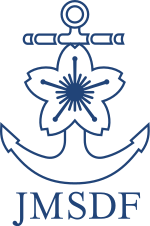 Emblem of the Japan Maritime Self-Defense Force | |
| Founded | 1 July 1954[1] |
| Country | |
| Type | Navy |
| Role | Maritime warfare |
| Size | 50,800 personnel 254 ships[2][3] 346 aircraft[4] |
| Part of | |
| Garrison/HQ | Ichigaya, Shinjuku, Tokyo, Japan |
| March | Gunkan March |
| Fleet | 19 submarines 4 helicopter carriers 26 destroyers 10 frigates 6 destroyer escorts 3 landing ships 30 minesweepers 6 patrol boats 8 training ships (21 auxiliaries) |
| Website | www |
| Commanders | |
| Commander-in-Chief | |
| Minister of Defense | |
| Chief of Staff, Joint Staff | |
| Chief of the Maritime Staff | |
| Insignia | |
| Commissioning Pennant | |
| Naval Ensign | 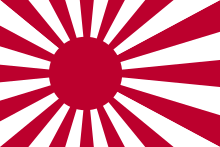 |
Since 2000, the JMSDF has been the world's fourth largest navy by total tonnage.[7]
History
Origin
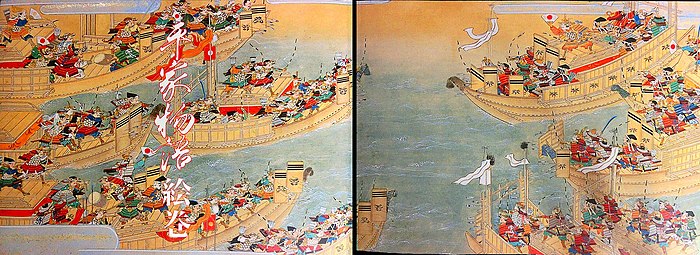
Japan has a long history of naval interaction with the Asian continent, involving the transportation of troops, starting at least with the beginning of the Kofun period in the 3rd century. Following the attempts at Mongol invasions of Japan by Kublai Khan in 1274 and 1281, Japanese wakō became very active in plundering the coast of the Chinese Empire.

Japan undertook major naval building efforts in the 16th century, during the Warring States period, when feudal rulers vying for supremacy built vast coastal navies of several hundred ships. Around that time, Japan may have developed one of the world's first ironclad warships, when Oda Nobunaga (a Japanese daimyō) had six iron-covered Oatakebune made in 1576.[8][9]
In 1588, Toyotomi Hideyoshi issued a ban on Wakō piracy; the pirates then became vassals of Hideyoshi and comprised the naval force used in the Japanese invasion of Korea.
Japan built her first large ocean-going warships in the beginning of the 17th century, following contact with European countries during the Nanban trade period. In 1613, the daimyō of Sendai, in agreement with the Tokugawa shogunate, built Date Maru. This 500 ton galleon-type ship transported the Japanese embassy of Hasekura Tsunenaga to the Americas and Europe. From 1604 onwards, about 350 Red seal ships, usually armed and incorporating European technology, were also commissioned by the shogunate, mainly for Southeast Asian trade.
Imperial Japanese Navy
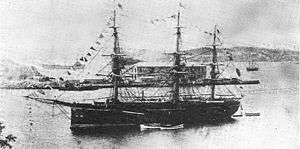
From 1868, the restored Meiji Emperor continued with reforms to industrialize and militarize Japan to prevent the United States and European powers from overwhelming it. On 17 January 1868, the Ministry of Military Affairs was established, with Iwakura Tomomi, Shimazu Tadayoshi and Prince Komatsu-no-miya Akihito as the First Secretaries.
On 26 March 1868, the first Naval Review was held in Japan (in Osaka Bay), with six ships from the private domainal navies of Saga, Chōshū, Satsuma, Kurume, Kumamoto and Hiroshima participating. The total tonnage of these ships was 2,252 tons, far smaller than the tonnage of the single foreign vessel (from the French Navy) that also participated. In July 1869, the Imperial Japanese Navy was formally established, two months after the last military engagement of the Boshin War – the private navies of the Japanese nobles were abolished and their 11 ships were added to the 7 surviving vessels of the defunct Tokugawa bakufu navy, including Kankō Maru, Japan's first steam warship.[10] This formed the core of the new Imperial Japanese Navy.
An 1872 edict officially separated the Japanese Navy from the Japanese Army. Politicians like Enomoto Takeaki set out to use the Navy to expand to the islands south of Japan in similar fashion to the Army's northern and western expansion. The Navy sought to upgrade its fleet to a blue water navy and used cruises to expand the Japanese consciousness on the southern islands. Enomoto's policies helped the Navy expand and incorporate many different islands into the Japanese Empire, including Iwo Jima in 1889. The navy continued to expand and incorporate political influence throughout the early twentieth century.[11]
The Japanese victory in the Russo-Japanese War of 1904–1905 marks the emergence of Japan as a major military power. Japan demonstrated that it could apply Western technology, discipline, strategy, and tactics effectively. The war concluded with the Treaty of Portsmouth. The complete victory of the Japanese military surprised world observers. The consequences transformed the balance of power in East Asia.
World War I
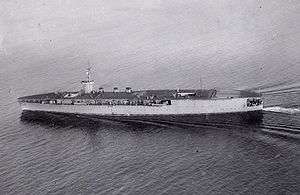
The Japanese seaplane carrier Wakamiya conducted the world's first successful naval-launched air raids on 5 September 1914 and during the first months of World War I from Kiaochow Bay off Tsingtao. On 6 September 1914 was the very first air-sea battle in history.[12] A Farman aircraft launched by Wakamiya attacked the Austro-Hungarian cruiser Kaiserin Elisabeth and the German gunboat Jaguar off Tsingtao. Four seaplanes bombarded German land targets. The Germans surrendered on 6 November 1914.[13][14]
In 1921, during the Interwar period, Japan developed and launched the Hōshō, which was the first purpose-designed aircraft carrier in the world.[15] Japan subsequently developed a fleet of aircraft carriers that was second to none except the United States and possibly Britain.
World War II

Over the course of the war, Japan displayed many significant advances in military technology, strategy, and tactics. Among them were the Yamato-class battleship, the Sen-Toku submarine bomber carriers, the Mitsubishi Zero fighters, and Kamikaze bombers.
Post-World War II
Following Japan's defeat in World War II, the Imperial Japanese Navy was dissolved by the Potsdam Declaration acceptance. Ships were disarmed, and some of them, such as the battleship Nagato, were taken by the Allied Powers as reparation. The remaining ships were used for repatriation of the Japanese soldiers from abroad and also for minesweeping in the area around Japan, initially under the control of the Second Bureau of the Demobilization Ministry.[16] The minesweeping fleet was eventually transferred to the newly formed Maritime Safety Agency, which helped maintain the resources and expertise of the navy.
Japan's 1947 Constitution was drawn up after the conclusion of the war, Article 9 specifying that "The Japanese people forever renounce war as a sovereign right of the nation and the threat or use of force as a means of settling international disputes." The prevalent view in Japan is that this article allows for military forces to be kept for the purposes of self-defense. Due to Cold War pressures, the United States was also happy for Japan to provide part of its own defense, rather than have it fully rely on American forces.
In 1952, the Coastal Safety Force was formed within the Maritime Safety Agency, incorporating the minesweeping fleet and other military vessels, mainly destroyers, given by the United States. In 1954, the Coastal Safety Force was separated, and the JMSDF was formally created as the naval branch of the Japan Self-Defense Forces (JSDF), following the passage of the 1954 Self-Defense Forces Law.
The first ships in the JMSDF were former U.S. Navy destroyers, transferred to Japanese control in 1954. In 1956, the JMSDF received its first domestically produced destroyer since World War II, Harukaze. Due to the Cold War threat posed by the Soviet Navy's sizable and powerful submarine fleet, the JMSDF was primarily tasked with an anti-submarine role.
Post Cold War
Following the end of the Cold War, the role of the JMSDF has vastly changed. In 1991, after much international pressure, the JMSDF dispatched four minesweepers, a fleet oiler (JDS Tokiwa) and a minesweeping tender (JDS Hayasse) to the Persian Gulf in the aftermath of the Gulf War, under the name of Operation Gulf Dawn, to clear mines sown by Saddam Hussein's defending forces;[17] and starting with a mission to Cambodia in 1993 when JSDF personnel were supported by JDS Towada,[17] it has been active in a number of UN-led peace keeping operations throughout Asia. In 1993, it commissioned its first Aegis-equipped destroyer, Kongō. It has also been active in joint naval exercises with other countries, such as the United States. The JMSDF has dispatched a number of its destroyers on a rotating schedule to the Indian Ocean in an escort role for allied vessels as part of the UN-led Operation Enduring Freedom.
21st Century

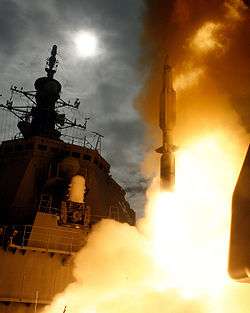
_vliegt_boven_Hy%C5%ABga_tijdens_oefening_Dawn_Blitz_2015%2C_-4_september_2015_a.jpg)
.jpg)
The JMSDF, along with the Japan Coast Guard, has also been active in preventing North Korean infiltrators from reaching Japan and on 22 December 2001, engaged and sank a North Korean spy ship in the Battle of Amami-Ōshima.[18]
In August 2003, a new "helicopter carrier" class was ordered, the Hyūga-class helicopter destroyer. The size and features of the ship, including a full-length flight deck, it was classified as a helicopter carrier by Lloyd's Register — similar to the United Kingdom's HMS Ocean. There was discussion about whether an aircraft carrier would be prohibited by Article 9 of the Japanese Constitution, since aircraft carriers are generally considered offensive weapons. In April 1988, the former chief of the Defense Agency, Tsutomu Kawara, said, "The Self-Defense Forces are not allowed to possess ICBMs (intercontinental ballistic missiles), strategic bombers, or attack aircraft carriers."[19] Historically (until about 1975 in the U.S. Navy) large-scale carriers were classified as "attack aircraft carriers" and the smaller carriers as "anti-submarine aircraft carriers". Since helicopter carriers have little built-in attack capability and they primarily fulfill defensive roles such as anti-submarine warfare, the Japanese government argues that the prohibition does not extend to helicopter carriers.
With an increase in tensions with North Korea following the 1993 test of the Nodong-1 missile and the 1998 test of the Taepodong-1 missile over northern Japan, the JMSDF has stepped up its role in air defense. A ship-based anti-ballistic missile system was successfully test-fired on 18 December 2007 and has been installed on Japan's Aegis-equipped destroyers.
In November 2009, the JMSDF announced plans for a larger "helicopter carrier", the Izumo-class helicopter destroyer. The first one of these ships was laid down in 2012[20][21][22] and was launched on 6 August 2013.[23]
The submarine fleet of the JMSDF consists of some of the most technologically advanced diesel-electric submarines in the world. This is due to careful defense planning in which the submarines are routinely retired from service ahead of schedule and replaced by more advanced models.[24] In 2010 it was announced that the Japanese submarine fleet would be increased in size for the first time in 36 years.[25]
After a meeting between the Japanese Foreign Minister and U.S. Ambassador to Japan on 4 March 2014, the Japanese Defense Ministry and U.S. Department of Defense announced they would hold studies for the joint development of the littoral vessel under the bilateral Mutual Defense Assistance agreement. The vessel is planned to be a high-speed trimaran designed for operations in shallow coastal waters capable of carrying helicopters, possibly a lighter variant of the American 3,000 tonne (3,300 short ton) Littoral Combat Ship. The study is in response to the growth of the Chinese People's Liberation Army Navy and budgetary issues with the U.S. military that may affect their ability to operate in the Pacific. The J-LCS would be used to intervene during Chinese ship incursions near the Senkaku Islands and other contested areas in the East China Sea, and possibly counter similar Chinese vessels like the Type 056 corvette and Type 022 missile boat. A 1,000 tonnes (980 long tons; 1,100 short tons) J-LCS with an enlarged hull could operate the SH-60K anti-submarine helicopter or the MCH-101 airborne mine countermeasures (AMCM) helicopter.[26]
On May 1, 2017, the JS Izumo was dispatched to protect a U.S Navy supply vessel in the Pacific. This was the first time the JMSDF has been used to defend allied vessels since the 2016 amendment to the Japanese Constitution.[27]
Japan christened the 84-meter long, 2,950 tons JS Ōryū submarine on October 4, 2018. It is Japan's first submarine powered by lithium-ion batteries and was developed by Mitsubishi Heavy Industries. The Japan Maritime Self-Defense Force will utilize it by March 2020.[28]
Japan and the United States conducted the biggest military exercise around Japan thus far in the biennial Keen Sword from 29 October to 2 November 2018. It included a total of 57,000 sailors, marines and airmen. 47,000 service members were from the JSDF and 10,000 from the U.S. Armed Forces. A naval supply ship and frigate of the Royal Canadian Navy also participated. There were simulations of air combat, ballistic missile defense and amphibious landings.[29]
On 18 December 2018, Japan announced it will refit the Izumo-class destroyers to carry US-designed F-35B fighter jets.[30] This makes them de facto aircraft carriers. To avoid controversy, the ruling parties call it a "multi-purpose operation destroyer". It would be the first such ship in the JMSDF since World War II.[31] On 23 May 2019, retired MSDF vice admiral Toshiyuki Ito stated that Japan requires at least four Izumo-class destroyers to be viable for real naval combat operations. He said “If you only have two vessels, you can only use them for training personnel for taking off and landing operations, so this plan doesn’t make sense for MSDF officers, frankly speaking.” As aircraft carriers, the Izumo-class destroyers are relatively small. Each ship can only carry approximately 10 F35Bs. That is too few aircraft for effective air defense of a naval fleet.[32] The Diet of Japan approved in 2019 the order of 42 STOVL Lockheed Martin F-35 Lightning IIs in addition to 135 F-35A model conventional takeoff and landing fighters for the Japanese Air Self Defense Force to operate from their land bases; the F-35B is same model aircraft that the US Marines operate from US Navy aircraft carriers and amphibious assault ships, the US Marines also plan to fly from the Japanese Izumo-class after the STOVL modifications and refit.[33]The US Marines will operate in cooperation their own STOVL F-35Bs to build up a Japanese capability to operate American fighters from Japanese ships when the situation requires. The Asahi Shimbun quotes Japan’s Defense Minister Takeshi Iwaya “The Izumo-class aircraft carrier role is to strengthen the air defense in the Pacific Ocean and to ensure the safety of the Self-Defense Force pilots”. he also states, “There may be no runway available for the US aircraft in an emergency. I cannot say that the US F35B should never be placed on an [JMSDF] escort vessel.” [34] According to an RT official interview of a Japanese Ministry of Defense representative, the STOVL aircraft are a land based Japan Air Self-Defense Force asset which when required can operate from remote locations and short strips as well as land safely even if the air base's runway is destroyed[35] it is a separate program from the modification of maritime escort vessels which is to “increase operational flexibility”, stating “We are not creating [Japanese] carrier air wings or carrier air squadrons”.[36]
Capabilities
The JMSDF has an official strength of 50,000 personnel, but presently numbers around 50,800 active personnel.
As a result of continuing effective defense investment due to Japan's economic development and an end to the Cold War, the JMSDF became the world's fourth largest navy by total tonnage by 2000.[7] Japan has the eighth largest Exclusive Economic Zone (EEZ) in the world,[37] and the JMSDF is responsible for protecting this large area. As an island nation, dependent on maritime trade for the majority of its resources, including food and raw materials, maritime operations are a very important aspect of Japanese defense policy.
The JMSDF is known in particular for its anti-submarine warfare and minesweeping capabilities. Defense planners believe the most effective approach to combating hostile submarines entails mobilizing all available weapons, including surface combatants, submarines, patrol planes, and helicopters. They are also known to operate at least fourteen listening stations all over the country that have ELINT and marine surveillance radar warning systems.[38]
Historically, the Japan Air Self-Defense Force (JASDF) has been relied on to provide air cover at sea, a role that is subordinate to the JASDF's primary mission of air defense of the home islands. Extended patrols over sea lanes are beyond the JASDF's current capabilities.
The Japanese fleet's capacity to provide ship-based antiaircraft warfare protection is limited by the absence of aircraft carriers, though its destroyers and frigates equipped with the Aegis combat system provide a formidable capability in antiaircraft and antimissile warfare. These capabilities are force multipliers, allowing force projection of Japan's sizable destroyer and frigate force far from home waters, and acquiring them is contentious considering Japan's "passive" defense policy.
Activities
International activities
_conducts_a_replenishment_at_sea_(RAS)_with_the_guided-missile_cruiser_USS_Anzio_(CG_68).jpg)
Mission in the Indian Ocean
Destroyers and combat support ships of Japan Maritime Self-Defense Force were dispatched to the Indian Ocean from 2001 to 2008 to participate in OEF-MIO (Operation Enduring Freedom-Maritime Interdiction Operation).[39] Their mission is to prevent the marine transportation of illegal weapons and ammunition, and the drugs which fund terrorist activity. Since 2004, the JMSDF has provided ships of foreign forces with fuel for their ships and ship-based helicopters, as well as fresh water.
This was the third time Japanese military vessels had been dispatched overseas since World War II, following the deployments of mine-sweeping units during the Korean War and the Persian Gulf War. The law enabling the mission expired on 2 November 2007, and the operation was temporarily canceled due to a veto of a new bill authorizing the mission by the opposition-controlled upper chamber of the Japanese Diet.
In January 2010, the defense minister ordered the JMSDF to return from the Indian Ocean, fulfilling a government pledge to end the eight-year refueling mission. Prime Minister Yukio Hatoyama refused to renew the law authorizing the mission, ignoring requests from the American government for continuation. Both the Western alliance country typified by the Royal Australian Navy and the Royal Danish Navy, doing friendship activities in the Indian Ocean.[40]
Mission in Somalia
In May 2010, Japan announced its intention to build a permanent naval base in Djibouti, from which it will conduct operations to protect merchant shipping from Somali pirates.[41]
Military exercises and exchanges
_in_formation_with_Japanese_and_American_ships_during_ANNUALEX_2008_081119-N-8842M-182.jpg)
The JMSDF and the U.S. Navy frequently carry out joint exercises and "U.S. Navy officials have claimed that they have a closer daily relationship with the JMSDF than any other navy in the world".[42] The JMSDF participates in RIMPAC, the annual multi-national military exercise near Hawaii that has been hosted by the U.S. Navy since 1980. The JMSDF dispatched a ship to the Russian Vladivostok harbor in July 1996 to participate in the Russian Navy's 300th anniversary naval review. Vladimir Vinogradov came by ship to the Tokyo harbor in June 1997. The JMSDF has also conducted joint naval exercises with the Indian Navy.
- RIMPAC: Japan Maritime Self-Defense Force participated in RIMPAC after 1980.
- Pacific Shield (PSI): The Japan Maritime Self-Defense Force has participated in Pacific Shield after 2004; and in 2007, the Japan Maritime Self-Defense Force hosted the exercise.
- Pacific Reach: The Japan Maritime Self-Defense Force has participated in the bi-annual submarine rescue exercise since 2000. In 2002, the Japan Maritime Self-Defense Force hosted the exercise.
- Navy to Navy Talks: The Japan Maritime Self-Defense Force holds regular naval conferences with its counterparts of Indonesia, Malaysia, Australia, the United Kingdom, and the United States of America.
- AEGIS Ballistic Missile Defense FTM: The Japan Maritime Self-Defense Force has participated in the FTM after FTM-10. The Japan Maritime Self-Defense Force carried out JFTM-1 in December 2007.
- The Japan Maritime Self-Defense Force participates in the United States Navy's Personnel Exchange Program (PEP) in which officers and enlisted personnel from each country serve fully integrated in the other country's navy for two years.
- Keen Sword is the biggest biennial military exercise around Japan. The participants are primarily Japan and the United States.
Equipment
Ships and submarines
The ship prefix JDS (Japanese Defense Ship) was used until 2008, at which time JMSDF ships started using the prefix JS (Japanese Ship) to reflect the upgrade of the Japanese Defense Agency to the Ministry of Defense. As of 2014, the JMSDF operates a total of 124 ships (excluding minor auxiliary vessels), including; two multi-purpose operation destroyers (de facto aircraft carriers), two helicopter carriers (called helicopter destroyers), 26 destroyers, 10 small destroyers (or frigates), six destroyer escorts (or corvettes), 18 attack submarines, 29 mine countermeasure vessels, six patrol vessels, three landing ship tanks, eight training vessels and a fleet of various auxiliary ships.[43] The fleet has a total displacement of approximately 624,000 tonnes (including auxiliary vessels).
Aircraft
The Japan Maritime Self-Defense Force aviation maintains a large naval air force, including 201 fixed-wing aircraft and 145 helicopters. Most of these aircraft are used in anti-submarine warfare operations.
Aircraft

.jpg)
| Aircraft | Origin | Type | Variant | In service | Notes |
|---|---|---|---|---|---|
| Maritime Patrol | |||||
| P-3 Orion | United States | ASW / maritime patrol | P-3C | 70[44] | 4 OP-3 variants provided reconnaissance |
| AP-3C Orion | United States | surveillance / ELINT | 4[44] | ||
| Kawasaki P-1 | Japan | ASW / maritime patrol | 19 | 2 on order[44] | |
| Learjet 35 | United States | surveillance | 36 | 4[44] | |
| Transport | |||||
| Super King Air | United States | utility | 90 | 18[44] | 13 provided training |
| C-130 Hercules | United States | transport | C-130R | 6[44] | |
| ShinMaywa US-2 | Japan | transport / SAR | 5[44] | ||
| Helicopters | |||||
| Sikorsky UH-60 | United States | ASW / SAR | SH-60K/J | 115[44] | licensed built by Mitsubishi |
| AgustaWestland AW101 | Italy | transport / minesweeper | 12[44] | ||
| Trainer Aircraft | |||||
| Fuji T-3 | Japan | trainer | 32[44] | ||
| P-3 Orion | United States | conversion trainer | UP-3D | 2[44] | |
| Airbus H135 | France | rotorcraft trainer | 15[44] | ||
Organization, formations and structure
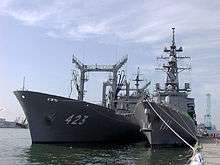
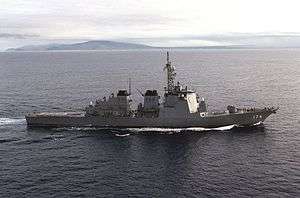
.jpg)
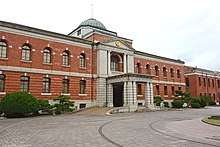
The JMSDF is commanded by the Chief of the Maritime Staff. Its structure consists of the Maritime Staff Office, the Self Defense Fleet, five regional district commands, the air-training squadron and various support units, such as hospitals and schools. The Maritime Staff Office, located in Tokyo, serves the Chief of Staff in commanding and supervising the force.
The Self-Defense Fleet, headquartered at Yokosuka, consists of the JMSDF's military shipping. It is composed of Fleet Escort Force (based in Yokosuka, Sasebo, Maizuru and Kure), the Fleet Air Force headquartered at Atsugi, Fleet Submarine Force based at Yokosuka and Kure, Mine Warfare Force based at Yokosuka and the Fleet Training Command at Yokosuka.[45]
On 6 March 2018, Ryoko Azuma became the first female squadron commander in the JMSDF. Her unit includes the flagship Izumo, the largest warship in the JMSDF. She commands four warships making up a division with a total of 1,000 crew members.[46]
Each Escort Flotilla is formed as an 8–8 fleet of eight destroyers and eight on-board helicopters, a modification of the old Japanese navy fleet layout of eight battleships and eight cruisers. Each force is composed of one helicopter destroyer (DDH) acting as a command ship, two guided-missile destroyers (DDG) and five standard or ASW destroyers (DD). The JMSDF is planning to reorganize the respective Escort Flotillas into a DDH group and DDG group, enabling faster overseas deployments.
- Prime Minister of Japan
- Minister of Defense
- JMSDF Chief of Staff / Maritime Staff Office
- Self Defense Fleet
- Fleet Escort Force
- Escort Flotilla 1 (Yokosuka)
- Escort Squadron 1: DDH-183 Izumo; DDG-179 Maya; DD-101 Murasame; DD-107 Ikazuchi (Yokosuka)
- Escort Squadron 5: DDG-173 Kongō; DD-108 Akebono; DD-109 Ariake; DD-115 Akizuki (Sasebo)
- Escort Flotilla 2 (Sasebo)
- Escort Squadron 2: DDH-182 Ise; DDG-178 Ashigara; DD-102 Harusame; DD-119 Asahi (Sasebo)
- Escort Squadron 6: DDG-174 Kirishima; DD-110 Takanami; DD-111 Onami; DD-116 Teruzuki (Yokosuka)
- Escort Flotilla 3 (Maizuru)
- Escort Squadron 3: DDH-181 Hyūga; DDG-175 Myōkō; DDG-177 Atago; DD-118 Fuyuzuki (Maizuru)
- Escort Squadron 7: DD-103 Yudachi; DD-112 Makinami; DD-114 Suzunami; DD-156 Setogiri (replacement in 2020 by DD-120 Shiranui) (Ominato)
- Escort Flotilla 4 (Kure)
- Escort Squadron 4: DDH-184 Kaga; DD-105 Inazuma; DD-106 Samidare; DD-113 Sazanami (Kure)
- Escort Squadron 8: DDG-172 Shimakaze; DDG-176 Chōkai; DD-104 Kirisame; DD-117 Suzutsuki (Sasebo)
- Naval District Forces:
- 11th Escort Squadron: DD-152 Yamagiri; DD-153 Yūgiri; DD-154 Amagiri (Yokosuka)
- 12th Escort Squadron: DD-158 Umigiri; DE-229 Abukuma; DE-234 Tone (Kure)
- 13th Escort Squadron: DD-157 Sawagiri; DE-230 Jintsū; DD-132 Asayuki (Sasebo)
- 14th Escort Squadron: DD-151 Asagiri; DE-232 Sendai; DD-130 Matsuyuki (Maizuru)
- 15th Escort Squadron: DD-155 Hamagiri; DE-231 Ōyodo; DE-233 Chikuma (Ominato)
- 1st Replenishment-at-Sea Squadron (Yokosuka): AOE-422 Towada (Kure); AOE-423 Tokiwa (Yokosuka); AOE-424 Hamana (Sasebo); AOE-425 Mashu (Mashu-class) (Maizuru); AOE-426 Omi (Mashu-class) (Sasebo)
- 1st Training Squadron: ATS-4202 Kurobe; ATS-4203 Tenryu; TV-3517 Shirayuki; TV-3519 Yamayuki; TV-3518 Setoyuki; TV-3513 Shimayuki (Kure)
- Fleet Training Command (Yokosuka)
- Escort Flotilla 1 (Yokosuka)
- Fleet Air Force
- Fleet Air Wing 1 (P-3C UH-60J)
- Fleet Air Wing 2 (P-3C UH-60J)
- Fleet Air Wing 4 (P-3C UH-60J)
- Fleet Air Wing 5 (P-3C UH-60J)
- Fleet Air Wing 21 (SH-60J/K)
- Fleet Air Wing 22 (SH-60J)
- Fleet Air Wing 31 (US-1A US-2 EP-3 OP-3C UP-3D LC-90 U-36A)
- Fleet Squadron 51 (P-1, P-3C UP-3C/D OP-3 SH-60J/K OH-6DA)
- Fleet Squadron 61 (C-130R LC-90)
- Mine Countermeasures Helicopter Squadron 111 (MCH-101)
- Fleet Submarine Force (Yokosuka)
- Submarine Flotilla 1 (Kure)
- Flotilla HQ: ASR-403 Chihaya
- Submarine Squadron 1: SS-507 Jinryū; SS-593 Makishio; SS-594 Isoshio
- Submarine Squadron 3: SS-504 Kenryū; SS-596 Kuroshio; SS-600 Mochishio
- Submarine Squadron 5: SS-501 Sōryū; SS-502 Unryū; SS-503 Hakuryū; SS-508 Sekiryū
- Kure Submarine Base Support Squadron
- Submarine Flotilla 2 (Yokosuka)
- Flotilla HQ: ASR-404 Chiyoda
- Submarine Squadron 2: SS-592 Uzushio; SS-595 Narushio; SS-597 Takashio
- Submarine Squadron 4: SS-505 Zuiryū; SS-598 Yaeshio; SS-599 Setoshio
- Submarine Squadron 6: SS-506 Kokuryū; SS-509 Seiryū
- Yokosuka Submarine Base Support Squadron
- 1st Submarine Training Squadron (Kure): TSS-3608 Oyashio; TSS-3609 Michishio
- Submarine Training Command (Kure)
- Yokosuka Submarine Training Detachment
- Submarine Flotilla 1 (Kure)
- Mine Warfare Force (Yokosuka)
- Minesweeper Squadron 1 (Yokosuka): MST-463 Uraga (Uraga class mine warfare command ship); MSO-304 Awaji (Awaji-class minesweeper); MSO-305 Hirado (Awaji-class minesweeper); MSC-606 Hatsushima (Enoshima-class minesweeper)
- Minesweeper Squadron 2 (Sasebo): MSC-601 Hirashima; MSC-602 Yakushima; MSC-603 Takashima (all three Hirashima-class minesweepers)
- Minesweeper Squadron 3 (Kure): MST-464 Bungo (Uraga class mine warfare command ship); MSC-688 Aishima (Sugashima-class minesweeper); MSC-690 Miyajima (Sugashima-class minesweeper)
- Minesweeper Squadron 101 (Kure): MSC-679 Yugeshima; MSC-680 Nagashima (both Uwajima-class minesweeper command boats); 4 minesweeping drone boats (SAM 1 - 4)
- Landing Ship Squadron 1 (Kure): LST-4001 Ōsumi; LST-4002 Shimokita; LST-4003 Kunisaki
- 1st Landing Craft Air Cushion Unit (Kure): LCAC-2101 - 2106
- Mine Warfare Support Center (Yokosuka)
- Mine Warfare Support Detachment Kure
- Fleet Research & Development Command
- Fleet Intelligence Command
- Oceanographic and ASW Support Command
- Fleet Escort Force
- Air Training Command
- Maritime Material Command
- Ship Supply Depot
- Air Supply Depot
- Training Division (Kure)
- Division HQ: TV-3508 Kashima
- Training Squadron 1: TV-3513 Shimayuki; TV-3518 Setoyuki; TV-3520 Hatakaze
- Communication Command
- Criminal Investigation Command
- Service Activity Tokyo
- Printing Supply Unit
- JMSDF Staff College
- Maritime Officer Candidate School
- 1st Service School
- 2nd Service School
- 3rd Service School
- 4th Service School
- Yokosuka District
- Kure District
- Sasebo District
- Maizuru District
- Ominato District
- Self Defense Fleet
- JMSDF Chief of Staff / Maritime Staff Office
- Minister of Defense
District Forces
Five district units act in concert with the fleet to guard the waters of their jurisdictions and provide shore-based support. Each district is home to a major JMSDF base and its supporting personnel and staff. Furthermore, each district is home to one or two regional escort squadrons, composed of two to three destroyers or destroyer escorts (DE). The destroyers tend to be of older classes, mainly former escort force ships. The destroyer escorts, on the other hand, tend to be purpose built vessels. Each district also has a number of minesweeping ships.
Fleet Air Force
The Fleet Air Force is tasked with patrol, ASW and rescue tasks. It is composed primarily of 7 aviation groups. Prominent bases are maintained at Kanoya, Hachinohe, Atsugi, Naha, Tateyama, Oomura and Iwakuni. The Fleet Air Force is built up mainly with patrol aircraft such as the Lockheed P-3 Orion, rescue aircraft such as the US-1A and helicopters such as the SH-60J. In the JMSDF, helicopters deployed to each escort force are actually members of Fleet Air Force squadrons based on land.
Special Forces
Special Forces units consist of the following:
- SBU (Special Boarding Unit)
- MIT (Maritime Interception Team)
Ranks
The following details the officer ranks of the JMSDF, showing the Japanese rank, the English translation and the NATO equivalent.
Officers(幹部)
| NATO code | OF-9 | OF-8 | OF-7 | OF-5 | OF-4 | OF-3 | OF-2 | OF-1 | |
|---|---|---|---|---|---|---|---|---|---|
| Rank | 海将 (統合幕僚長および海上幕僚長) | 海将 | 海将補 | 1等海佐 | 2等海佐 | 3等海佐 | 1等海尉 | 2等海尉 | 3等海尉 |
| English translation | Admiral | Vice admiral | Rear admiral | Captain | Commander | Lieutenant commander | Lieutenant | Lieutenant junior grade | Ensign |
| Insignia Type A (甲階級章) |
.svg.png) | .svg.png) | .svg.png) |
.svg.png) | .svg.png) | .svg.png) |
.svg.png) | .svg.png) | .svg.png) |
| Insignia Type B (乙階級章) |
.svg.png) | .svg.png) | .svg.png) |
.svg.png) | .svg.png) | .svg.png) |
.svg.png) | .svg.png) | .svg.png) |
| Insignia Type C (丙階級章) |
.svg.png) | .svg.png) | .svg.png) |
.svg.png) | .svg.png) | .svg.png) |
.svg.png) | .svg.png) | .svg.png) |
| Insignia Miniature Type (略章) |
.svg.png) | .svg.png) | .svg.png) |
.svg.png) | .svg.png) | .svg.png) |
|||
Warrant Officer & Enlisted(准尉および曹士)
| NATO code | OR-9 | OR-8 | OR-7 | OR-6 | OR-5 | OR-3 | OR-2 | OR-1 | OR-D |
|---|---|---|---|---|---|---|---|---|---|
| Rank | 准海尉 | 海曹長 | 1等海曹 | 2等海曹 | 3等海曹 | 海士長 | 1等海士 | 2等海士 | 自衛官候補生 |
| English translation | Warrant officer | Chief petty officer | Petty officer 1st class | Petty officer 2nd class | Petty officer 3rd class | Leading seaman | Seaman | Seaman apprentice | Self defense official cadet |
| Insignia Type A (甲階級章) |
.svg.png) | .svg.png) | .svg.png) | .svg.png) | .svg.png) |
.svg.png) | .svg.png) | ||
| Insignia Type B (乙階級章) |
.svg.png) | .svg.png) | .svg.png) | .svg.png) | .svg.png) |
.svg.png) | .svg.png) | .svg.png) | .svg.png) |
| Insignia Type C (丙階級章) |
.svg.png) | .svg.png) | .svg.png) | .svg.png) | .svg.png) |
.svg.png) | .svg.png) | No insignia | |
| Insignia Miniature Type (略章) |
.svg.png) | .svg.png) | .svg.png) | .svg.png) | .svg.png) | No insignia |
Culture and naming conventions
Although Japan's Ground Self-Defense Force has almost dropped traditions associated with the Imperial Japanese Army save for the march music tradition (Review March is the official march of the IJA and today's JGSDF), the JMSDF has maintained these historic links with the Imperial Japanese Navy. Today's JMSDF continues to use the same martial songs, naval flags, signs, and technical terms as the IJN. For example, the official flag of the JMSDF is the same as that used by the IJN. Also, the JMSDF tradition of eating Japanese curry every Friday lunch originated with the IJN. The JMSDF still uses the Warship March, the old service march of the IJN, as its official service march. It also maintains the IJN bugle calls tradition, as every ship and shore establishment command maintain a platoon or squad of bugle players.
The ship prefix JDS (Japanese Defense Ship) was used until 2008, at which time JMSDF ships started using the prefix JS (Japanese Ship) to reflect the upgrade of the Japanese Defense Agency to the Ministry of Defense.
Ships of the JMSDF, known as Japan Ships (自衛艦; Ji'ei-Kan), are classified according to the following criteria:
| Class | Type | Symbol | Building # | # | Naming | |
|---|---|---|---|---|---|---|
| Major class | Minor class | |||||
| Combatant Ship | Combatant Ship | Destroyer | DD | 1601- | 101- | Names of natural phenomena in the heavens or the atmosphere, mountains, rivers or regions |
| Destroyer escort | DE | 1201- | 201- | |||
| Submarine | SS | 8001- | 501- | Names of natural phenomena in the ocean or maritime animals | ||
| Mine Warfare Ship | Minesweeper Ocean | MSO | 201- | 301- | Names of islands, straits, channels or one that added a number to the type | |
| Minesweeper Coast | MSC | 301- | 601- | |||
| Minesweeping Controller | MCL | - | 721- | |||
| Minesweeper Tender | MST | 462- | 461- | |||
| Patrol Combatant Craft | Patrol Guided Missile Boat | PG | 821- | 821- | Names of birds, grass or one that added a number to the type | |
| Patrol Boat | PB | 921- | 901- | |||
| Amphibious Ship | Landing Ship, Tank | LST | 4101- | 4001- | Names of peninsulas, capes or one that added a number to the type | |
| Landing Ship Utility | LSU | 4171- | 4171- | |||
| Landing Craft Utility | LCU | 2001– | 2001– | |||
| Landing Craft Air Cushioned | LCAC | - | 2001– | |||
| Auxiliary Ship | Auxiliary Ship | Training Ship | TV | 3501- | 3501- | Names of places of natural beauty and historic interest or one that added a number to the type or the model |
| Training Submarine | TSS | - | - | |||
| Training Support Ship | ATS | 4201- | 4201- | |||
| Multipurpose Support Ship | AMS | - | - | |||
| Oceanographic Research Ship | AGS | 5101- | 5101- | |||
| Ocean Surveillance Ship | AOS | 5201- | 5201- | |||
| Ice breaker | AGB | 5001- | 5001- | |||
| Cable Repairing Ship | ARC | 1001- | 481- | |||
| Submarine Rescue Ship | ASR | 1101- | 401- | |||
| Submarine Rescue Tender | AS | 1111- | 405- | |||
| Experimental Ship | ASE | 6101- | 6101- | |||
| Fast Combat Support Ship | AOE | 4011- | 421- | |||
| Service Utility Ship | ASU | - | 7001- | |||
| Service Utility Craft | ASU | 81- | 61- | |||
| Service Yacht | ASY | 91- | 91- | |||
Recruitment and training
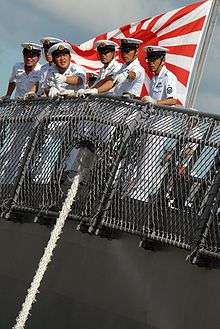
JMSDF recruits receive three months of basic training followed by courses in patrol, gunnery, mine sweeping, convoy operations and maritime transportation. Flight students, all upper-secondary school graduates, enter a two-year course. Officer candidate schools offer six-month courses to qualified enlisted personnel and those who have completed flight school.
Graduates of four-year universities, the four-year National Defense Academy, and particularly outstanding enlisted personnel undergo a one-year officer course at the Officer Candidate School at Etajima (site of the former Imperial Naval Academy). The JMSDF also operates a staff college in Tokyo for senior officers.
The large volume of coastal commercial fishing and maritime traffic around Japan limits in-service sea training, especially in the relatively shallow waters required for mine laying, mine sweeping and submarine rescue practice. Training days are scheduled around slack fishing seasons in winter and summer—providing about ten days during the year.
The JMSDF maintains two oceangoing training ships and conducted annual long-distance on-the-job training for graduates of the one-year officer candidate school.[45]
See also
| Wikimedia Commons has media related to Japan Maritime Self-Defense Force. |
- Imperial Japanese Navy
- Japanese ship naming conventions
- Military ranks and insignia of the Japan Self-Defense Forces
- Ships transferred from the United States Navy to the Japan Maritime Self-Defense Force [Category]
- Shipping Control Authority for the Japanese Merchant Marine – Post-WWII Occupation era organisation
- Naval Computer and Telecommunications Station Yokosuka, Japan – US Navy facility key to MSDF/USN operational co-ordination.
- Kaiwo Maru (1989)
References
- "History - Japanese Maritime Self Defense Force". Japan Ministry of Defense. Retrieved 23 May 2020.
- "C㎩qFM[Fʐ^M[Fq́i͒j". Retrieved 25 December 2014.
- "海上自衛隊:ギャラリー:潜水艦(艦艇)". Retrieved 25 December 2014.
- "Flightglobal - World Air Forces 2015" (PDF). Flightglobal.com.
- Kyle, Mizokami. "Sorry, China: Why the Japanese Navy is the Best in Asia". The National Interest. Retrieved 5 June 2020.
- "Japan> National Security> Self-Defense Forces> Early Development". Library of Congress Country Studies. Retrieved 9 May 2015.
- Crisher; Souva, Brian Benjamin; Mark (2014). "Power At Sea: A Naval Power Dataset, 1865-2011" (PDF). International Interactions. 40:4: 602–629.
- Thach, Marcel. "The Madness of Toyotomi Hideyoshi". The Samurai Archives. Retrieved 19 July 2008.
- Samson, George (1961). A History of Japan, 1334–1615. Stanford University Press. p. 309. ISBN 0-8047-0525-9.
- Schauffelen, Otmar (2005). Chapman Great Sailing Ships of the World. Hearst. p. 186. ISBN 1-58816-384-9.
- Schencker, J. Charles (October 1999). "The Imperial Japanese Navy and the Constructed Consciousness of a South Seas Destiny, 1872–1921". Modern Asian Studies. 33 (4): 769–96. doi:10.1017/s0026749x99003649.
- Wakamiya is "credited with conducting the first successful carrier air raid in history"Source:GlobalSecurity.org Austrian SMS Radetzky launched sea plane raids a year earlier
- John Pike. "IJN Wakamiya Aircraft Carrier". globalsecurity.org. Retrieved 1 April 2015.
- Peattie 2007, p. 9.
- "The Imperial Japanese Navy was a pioneer in naval aviation, having commissioned the world's first built-from-the-keel-up carrier, the Hōshō.".
- Graham, Euan (2006). Japan's Sea Lane Security, 1940–2004: A Matter Of Life And Death?. Nissan Institute/Routledge Japanese Studies Series. Routledge. p. 307. ISBN 0-41535-640-7.
- Woolley, Peter J. (1996). "The Kata of Japan's Naval Forces," Naval War College Review, XLIX, 2: 59–69.
- "Japan says 'spy ship' fired rockets". BBC News. 25 December 2001. Retrieved 29 January 2009.
- "Japanese Aircraft Carrier". Global Security. 3 August 2012. Retrieved 7 November 2012.
- Demetriou, Danielle (23 November 2009). "Japan to build fleet's biggest helicopter destroyer to fend off China". The Daily Telegraph. London. Retrieved 5 May 2010.
- Archived June 17, 2010, at the Wayback Machine
- Archived June 20, 2012, at the Wayback Machine
- "Japan unveils new carrier-like warship, largest in navy since WWII". Fox News. Associated Press. 6 August 2013. Retrieved 9 May 2015.
- Yoshihara, Toshi; Holmes, James R. "The Next Arms Race - APAC 2020, the decade ahead". The Diplomat. Archived from the original on 18 August 2011. Retrieved 25 December 2014.
- "Japan to Beef Up Submarines to Counter Chinese Power". The Chosun Ilbo (English Edition). 26 July 2010. Retrieved 25 December 2014.
- "US, Japan to Jointly Develop Littoral Combat Ship". The Diplomat. 7 March 2014. Retrieved 9 May 2015.
- "Japan issues 1st order to protect US ships amid N.K. tension". The Mainichi. 1 May 2017. Retrieved 1 May 2017.
- "Japan's silent submarines extend range with new batteries". Nikkei Asian Review. 5 October 2018. Archived from the original on 2018-10-05. Retrieved 5 October 2018.
- "U.S. carrier leads warships in biggest Japan defense war game". Asahi Shimbun. 4 November 2018. Archived from the original on 2018-11-05. Retrieved 6 November 2018.
- "Japan to induct Aircraft Carrier – first one after WW2". TheIndependent.in. 18 December 2018. Retrieved 18 December 2018.
- "Japan avoids flak by refusing to call flattop 'aircraft carrier'". The Asahi Shimbun. 6 December 2018. Archived from the original on 9 December 2018. Retrieved 29 December 2018.
- "Japan's plan to remodel Izumo-class carriers: Needed upgrade or mere show of force?". The Japan Times. 23 May 2019. Archived from the original on 4 June 2019. Retrieved 19 June 2019.
- https://edition.cnn.com/2018/12/18/asia/japan-aircraft-carriers-intl/index.html
- https://www.navalnews.com/naval-news/2019/08/usmc-to-first-fly-f-35b-from-japans-izumo-class-aircraft-carriers/
- https://www.rafmuseum.org.uk/research/collections/hawker-siddeley-harrier-gr3/
- https://www.rt.com/news/446747-japan-first-aircraft-carriers/
- "海洋白書 2004". Nippon Foundation. Retrieved 11 February 2008.
- http://press-files.anu.edu.au/downloads/press/p309261/pdf/ch091.pdf
- "About activity based on Antiterrorism Law". Japan Ministry of Defense. Archived from the original on 28 January 2008. Retrieved 11 February 2008.
- Fackler, Martin (15 January 2010). "Japan: Navy Ends Mission in Support of Afghan War". New York Times. Retrieved 9 May 2015.
- "Japan to build navy base in Gulf of Aden". UPI. 11 May 2010. Retrieved 25 December 2014.
- CRS RL33740 The Changing U.S.-Japan Alliance: Implications for U.S. Interests Archived June 9, 2011, at the Wayback Machine
- Pike, John. "Japanese Warships - Equipment Holdings". Global Security. Retrieved 25 December 2014.
- "World Air Forces 2020". Flightglobal Insight. 2020. Retrieved 16 June 2020.
- Dolan, Ronald; Robert Worden (1992). "8". Japan : A Country Study. Federal Research Division, Library of Congress. ISBN 0-8444-0731-3. See section 2: "The Self Defense Forces"
- "Japan's navy appoints Ryoko Azuma first female commander of warship squadron | 06.03.2018". Deutsche Welle. Retrieved 27 December 2019.
Further reading
- Agawa, Naoyuki. Friendship across the Seas: The US Navy and the Japan Maritime Self-Defense Force. Tokyo: Japan Publishing Industry Foundation for Culture, 2019. ISBN 978-4-86658-055-5
- Auer, James. The Postwar Rearmament of Japanese Maritime Forces, 1945–1971. New York: Praeger, 1973. ISBN 0-275-28633-9
- Auer, James. "Japan's Changing Defense Policy," The New Pacific Security Environment. Ralph A. Cossa, ed. Wash. D.C.: National Defense University, 1993.
- Jane's Intelligence Review, February 1992.
- Jane's Defence Weekly 17 August 1991
- Midford, Paul. "Japan’s Response to Terror: Dispatching the SDF to the Arabian Sea," Asian Survey, 43:2 (March/April 2003).
- Rubinstein, G.A. and J. O'Connell. "Japan's Maritime Self-Defense Forces," Naval Forces. 11: 2 (1990).
- Sekino, Hideo. "Japan and Her Maritime Defense," U.S. Naval Institute Proceedings, (May 1971).
- Sekino, Hideo. "A Diagnosis of our Maritime Self-Defense Force," Sekai no Kansen (Ships of the World), November 1970.
- Takei, Tomohisa,"Japan Maritime Self Defense Force in the New Maritime Era," Hatou, 34: 4(November 2008).
- Tsukigi, Shinji, "External and Internal Factors Shaping The Japan Maritime Self-Defense Force (JMSDF)." Monterey, Cal.: Naval Postgraduate School, June 1993. Master's thesis.
- Wile, Ted Shannon. Sealane Defense: An Emerging Role for the JMSDF?. Master's Thesis, Naval Postgraduate School (1981).
- Woolley, Peter J (1996). "Japan's 1991 Minesweeping Decision: An Organizational Response". Asian Survey. 36 (8): 804–817. doi:10.1525/as.1996.36.8.01p0159v.
- Woolley, Peter J. Japan’s Navy: Politics and Paradox 1971–2000. London: Lynne-Reinner: 2000. ISBN 1-55587-819-9
- Yamaguchi, Jiro. "The Gulf War and the Transformation of Japanese Constitutional Politics," Journal of Japanese Studies, Vol. 18 (Winter 1992).
- Young, P. Lewis. "The Japanese Maritime Self-Defense Forces: Major Surface Combatants Destroyers and Frigates," Asian Defense Journal (1985).